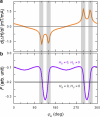Signatures of magnetism control by flow of angular momentum
- PMID: 39232172
- PMCID: PMC11410660
- DOI: 10.1038/s41586-024-07914-y
Signatures of magnetism control by flow of angular momentum
Abstract
Exploring new strategies to manipulate the order parameter of magnetic materials by electrical means is of great importance not only for advancing our understanding of fundamental magnetism but also for unlocking potential applications. A well-established concept uses gate voltages to control magnetic properties by modulating the carrier population in a capacitor structure1-5. Here we show that, in Pt/Al/Fe/GaAs(001) multilayers, the application of an in-plane charge current in Pt leads to a shift in the ferromagnetic resonance field depending on the microwave frequency when the Fe film is sufficiently thin. The experimental observation is interpreted as a current-induced modification of the magnetocrystalline anisotropy ΔHA of Fe. We show that (1) ΔHA decreases with increasing Fe film thickness and is connected to the damping-like torque; and (2) ΔHA depends not only on the polarity of charge current but also on the magnetization direction, that is, ΔHA has an opposite sign when the magnetization direction is reversed. The symmetry of the modification is consistent with a current-induced spin6-8 and/or orbit9-13 accumulation, which, respectively, act on the spin and/or orbit component of the magnetization. In this study, as Pt is regarded as a typical spin current source6,14, the spin current can play a dominant part. The control of magnetism by a spin current results from the modified exchange splitting of the majority and minority spin bands, providing functionality that was previously unknown and could be useful in advanced spintronic devices.
© 2024. The Author(s).
Conflict of interest statement
The authors declare no competing interests.
Figures














References
-
- Ohno, H. et al. Electric-field control of ferromagnetism. Nature408, 944–946 (2000). - PubMed
-
- Chiba, D. et al. Magnetization vector manipulation by electric fields. Nature455, 515–518 (2008). - PubMed
-
- Weisheit, M. et al. Electric field-induced modification of magnetism in thin-film ferromagnets. Science315, 349–351 (2007). - PubMed
-
- Chen, L., Matsukura, F. & Ohno, H. Electric-field modulation of damping constant in a ferromagnetic semiconductor (Ga,Mn)As. Phys. Rev. Lett.115, 057204 (2015). - PubMed
-
- Matsukura, F., Tokura, Y. & Ohno, H. Control of magnetism by electric fields. Nat. Nanotechnol.10, 209–220 (2015). - PubMed
LinkOut - more resources
Full Text Sources

